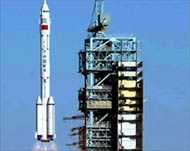Japan back in space race
A Japanese H-2A rocket has blasted off and successfully placed a satellite in orbit, bolstering Japan’s once-proud space programme – now languishing in China’s shadow.

The 53-metre orange and white rocket, with the word “Nippon,” or Japan, emblazoned on its side, roared up into a cloudy sky just before sunset from the sprawling space centre on Tanegashima island.
Mission control said the rocket successfully put its payload, a multipurpose weather and navigation satellite, into orbit about 40 minutes after lift-off.
The success on Saturday was a major breakthrough after a similar attempt 15 months ago ended in a spectacular fireball.
Japan’s space agency, JAXA, was counting on a successful launch to help revive the reputation of the H-2A – the centre piece of Japan’s space programme – and to demonstrate that Japan remains a viable contender in an increasingly heated space race with China.
Humiliating failure
All H-2A launches had been put on hold after a humiliating failure minutes after lift off from the main pad in November 2003.
 |
|
China says it is now aiming |
Controllers had to detonate that rocket and its payload of two spy satellites in midair after a booster failed to detach.
The setback was all the more frustrating because it came just one month after China successfully launched its first astronaut into orbit.
Beijing has since announced it is aiming for the moon.
Japan – which in 1972 became the fourth country to launch a satellite and which has long seen itself as Asia‘s leading space-faring nation – has no manned space programme of its own.
Chinese challenge
Aware of the Chinese challenge, a government panel last year recommended that Japan begin studying that possibility, however.
In the meantime, officials have stressed that the H-2A, which was designed and built in Japan, has a relatively good – if not perfect – record.
The 2003 failure came after five-straight successes, giving it an 83% success rate.
Europe’s Arianne 5 and China‘s Long March III both have about an 85% rate.
Even so, Japanese hopes that the H-2A would become an attractive competitor in the commercial launching business have yet to pan out because of the rocket’s high cost and infrequent lift offs.
JAXA officials stress that because Japan‘s space programme, which has a budget of about 260 billion yen ($2.5 billion), is strictly non-military it can afford only one or two launches a year.
Japan’s spy satelites
They say that is the main reason why Japan – despite being Asia’s richest and most technologically advanced nation – is falling behind China.
But the nature of Japan‘s space programme is changing.
The perceived threat from communist neighbour North Korea, which launched a Taepodong 1 missile over Japan‘s main island in 1998, has provided a strong impetus for Tokyo to beef up its space capabilities.
In part of a $2 billion programme, Japan launched its first spy satellites months before the 2003 failure.
Another set of spy satellites is now awaiting launch, though a date has not been set.
Though controversial in Japan and strongly condemned by Pyongyang, the programme is not technically a military one – it is not paid for through military funds, and officials say it poses no threat to North Korea or any other country.